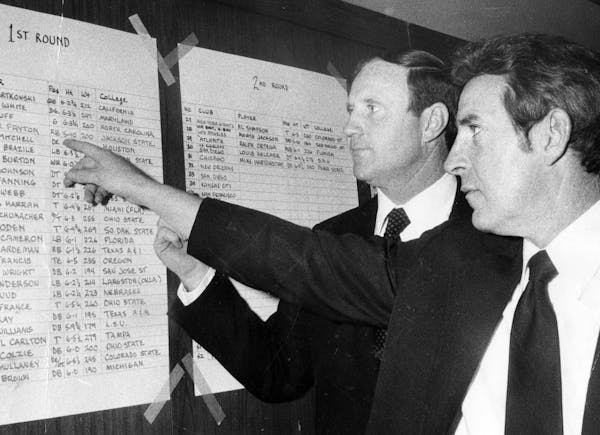The Vikings, like many teams, will enter this weekend's NFL draft with the intention of selecting a safety, a position that now has increased job responsibilities as spread passing attacks and athletic tight ends have become commonplace at the pro level.
The problem is that the supply does not match the demand, and the style of offense played at the college level has made safety one of the toughest positions for the NFL to evaluate.
"The need in the NFL is so great at safety now because of the type of receivers we have, whether we want to call them tight ends or [wide receivers]," NFL Network analyst Charles Davis said. "[With the] rocked-up wide receivers that are running downfield, there is a screaming need for them. But the colleges aren't developing the same way due to [prevalence of spread offenses] and where guys are being played."
This year, only Alabama safety Landon Collins is considered to be a strong candidate to be selected in the first round. Beyond him, many draft analysts believe that there is a significant drop-off in ability. For example, ESPN's Scouts Inc. has only three other safeties ranked among its top 100 prospects heading into Thursday night's first round.
Why aren't there many standout safeties to choose from? To find the answer to that question, you might want to look back at the recruiting classes from 2011 and 2012.
"You'll get a kid that's a five-star [recruit] and he can play receiver and he can play safety, and just about every time colleges are putting them at receiver," said NFL Network analyst Daniel Jeremiah, a former scout who has worked for three NFL teams.
Former Cleveland Browns General Manager Phil Savage noted the same trend, saying that only powerhouse NCAA programs such as Alabama, LSU, USC and Florida State have the depth and talent to allow them to stick top recruits on defense.
"It's all about scoring points. Your biggest, fastest players are typically staying on the offensive side of the ball," said Savage, now an analyst for SiriusXM NFL Radio. "I think there's a real disparity in terms of the volume of offensive skill players vs. defensive skill players. So that being said, [NFL teams] really have to search far and wide to find top-flight corners and top-flight safeties."
Different skills
And with the way the game is being played at the college level, with offenses using five-receiver sets and some defenses responding by deploying linebacker-sized defensive ends and safety-sized linebackers, it has become more difficult for scouts and other NFL talent evaluators to determine how safeties will translate to the pros.
"You have to watch more tape on that position than any other because of the spread offenses and the college game," Jeremiah said. "It's bubble screen right, bubble screen left and you look down at your notes, you've watched three or four games on a safety and I don't have anything about his ability to range off the hash, to be able to make plays across the field, route recognition, being able to make drives and make plays on the ball, … angles and their ability to break down a tackle in space."
While few things irk Vikings coach Mike Zimmer more than missed tackles, he covets coverage ability above all else from his safeties. And even after watching several hours of game tape, a scout still might not have a sense of whether a safety can actually be counted on to line up deep and cover enough ground in the pros.
"The safeties, it's not that they don't have the cover skills. But they never really work on it at practice either," said Jamaal Stephenson, Vikings director of college scouting. "It is difficult to find a safety in today's game, especially if you're looking for big, physical guys who can also run and cover."
Getting creative
The Vikings have one of the league's most versatile safeties in Harrison Smith, who was the only NFL player with at least five interceptions and three sacks last season.
They were unable to find a consistent partner for Smith, who they often used near the line of scrimmage, especially on third down. But it was not for a lack of trying.
The Vikings signed veterans Chris Crocker and Kurt Coleman last offseason, and they have recently spent draft picks on a pair of college cornerbacks and converted them to safety. Robert Blanton, a fifth-round pick in 2012, started 13 games next to Smith last season. Antone Exum, a sixth-rounder in 2014, made the team as a backup.
This offseason, they signed physical safety Taylor Mays, one of Zimmer's former Bengals players. But they are still looking to bring in competition for Blanton, Exum and Andrew Sendejo, who started the final three games of 2014 at strong safety.
Top candidates
"I think what's changing is the traits of the safeties," Vikings General Manager Rick Spielman said. "There are not a lot of box safeties anymore. Nowadays, they have to have the position flexibility to play both free and strong."
The Vikings have done their homework on college safeties such as Collins, Virginia's Anthony Harris, Arizona State's Damarious Randall and Minnesota's Cedric Thompson.
Spielman also indicated that they have been looking for "some big corners" who are capable of playing safety in the NFL, full time or part time.
Considering how shallow the talent pool is, the Vikings might have to draft a true safety in the first few rounds or try to get creative once again late.
"You're trying to dig them up from everywhere," Spielman said.
Staff writer Mark Craig contributed to this story.
